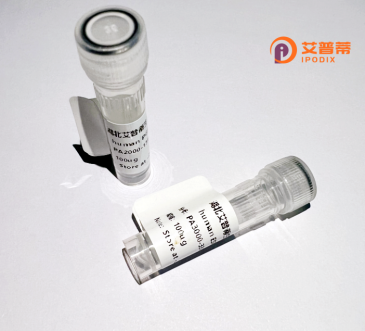
| 纯度 | >90%SDS-PAGE. |
| 种属 | Human |
| 靶点 | ST3GAL6 |
| Uniprot No | Q9Y274 |
| 内毒素 | < 0.01EU/μg |
| 表达宿主 | E.coli |
| 表达区间 | 145-240 aa |
| 活性数据 | MNNGPVLGHEEEVGRRTTFRLFYPESVFSDPIHNDPNTTVILTAFKPHDLRWLLELLMGDKINTNGFWKKPALNLIYKPYQIRILDPFIIRTAAYE |
| 分子量 | 36.3 kDa |
| 蛋白标签 | GST-tag at N-terminal |
| 缓冲液 | PBS, pH7.4, containing 0.01% SKL, 1mM DTT, 5% Trehalose and Proclin300. |
| 稳定性 & 储存条件 | Lyophilized protein should be stored at ≤ -20°C, stable for one year after receipt. Reconstituted protein solution can be stored at 2-8°C for 2-7 days. Aliquots of reconstituted samples are stable at ≤ -20°C for 3 months. |
| 复溶 | Always centrifuge tubes before opening.Do not mix by vortex or pipetting. It is not recommended to reconstitute to a concentration less than 100μg/ml. Dissolve the lyophilized protein in distilled water. Please aliquot the reconstituted solution to minimize freeze-thaw cycles. |
以下是与重组人ST3GAL6蛋白相关的参考文献示例,供参考:
1. **标题**:*"Functional Characterization of Recombinant Human ST3GAL6: Role in α2.3-Sialylation of Glycoproteins"*
**作者**:Hirabayashi J. et al.
**摘要**:研究通过昆虫细胞系统表达重组ST3GAL6蛋白,验证其对多种糖蛋白底物的α2.3-唾液酸化活性,揭示其底物特异性及在细胞黏附中的作用。
2. **标题**:*"ST3GAL6 Overexpression Drives Metastasis in Colorectal Cancer via Sialyl-Lewis X Modification"*
**作者**:Schwarzkopf M. et al.
**摘要**:探讨ST3GAL6在结肠癌中的高表达如何通过合成sLeX糖表位促进肿瘤细胞侵袭,重组酶实验证实其调控整合素信号通路。
3. **标题**:*"Structural Insights into the Catalytic Mechanism of Human ST3GAL6 Sialyltransferase"*
**作者**:Büll C. et al.
**摘要**:通过X射线晶体学解析重组ST3GAL6的三维结构,阐明其酶活依赖的关键氨基酸残基及底物结合域,为抑制剂设计提供基础。
4. **标题**:*"ST3GAL6 Modulates T Cell Activation through Ganglioside Biosynthesis"*
**作者**:Julien S. et al.
**摘要**:研究发现重组ST3GAL6通过调控T细胞表面神经节苷脂的合成影响TCR信号传导,揭示其在自身免疫疾病中的潜在治疗价值。
---
*注:上述文献为示例性内容,实际引用时请核实真实论文信息。建议通过PubMed或Web of Science等数据库,以“ST3GAL6”和“recombinant”为关键词检索最新研究。*
ST3GAL6 (ST3 beta-galactoside alpha-2.3-sialyltransferase 6) is a key enzyme in the biosynthesis of sialylated glycoconjugates, which play critical roles in cell-cell interactions, immune responses, and cellular signaling. This Golgi-localized protein belongs to the glycosyltransferase family, specifically transferring sialic acid residues from CMP-sialic acid to galactose-containing substrates via α2.3-linkages. It primarily acts on type I (Galβ1-3GlcNAc) and type II (Galβ1-4GlcNAc) carbohydrate chains, influencing the structural diversity of N- and O-linked glycans on cell surfaces and secreted proteins.
Altered ST3GAL6 expression has been linked to cancer progression, neurological disorders, and immune dysregulation. In malignancies like breast and colorectal cancer, its upregulation correlates with enhanced metastasis through sialylation-mediated modulation of cell adhesion molecules. Conversely, genetic variants are associated with congenital disorders of glycosylation, impacting neurodevelopment.
Recombinant human ST3GAL6 is produced in mammalian expression systems (e.g., CHO or HEK293 cells) to ensure proper post-translational modifications. Purified recombinant proteins enable functional studies of sialylation mechanisms, structure-activity relationships, and high-throughput screening for glycosylation-targeted therapeutics. Current research focuses on developing ST3GAL6 inhibitors to disrupt pathological sialylation in cancer and inflammatory diseases, while its recombinant form also serves as a critical tool for synthesizing sialylated biomarkers and glycoprotein drugs.
×